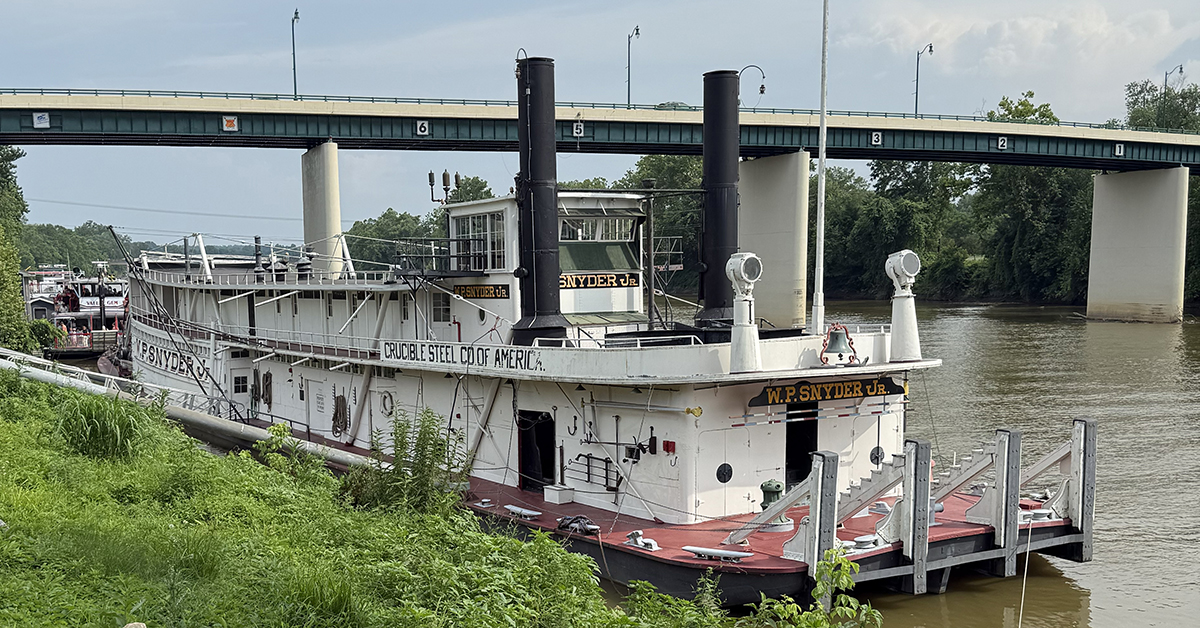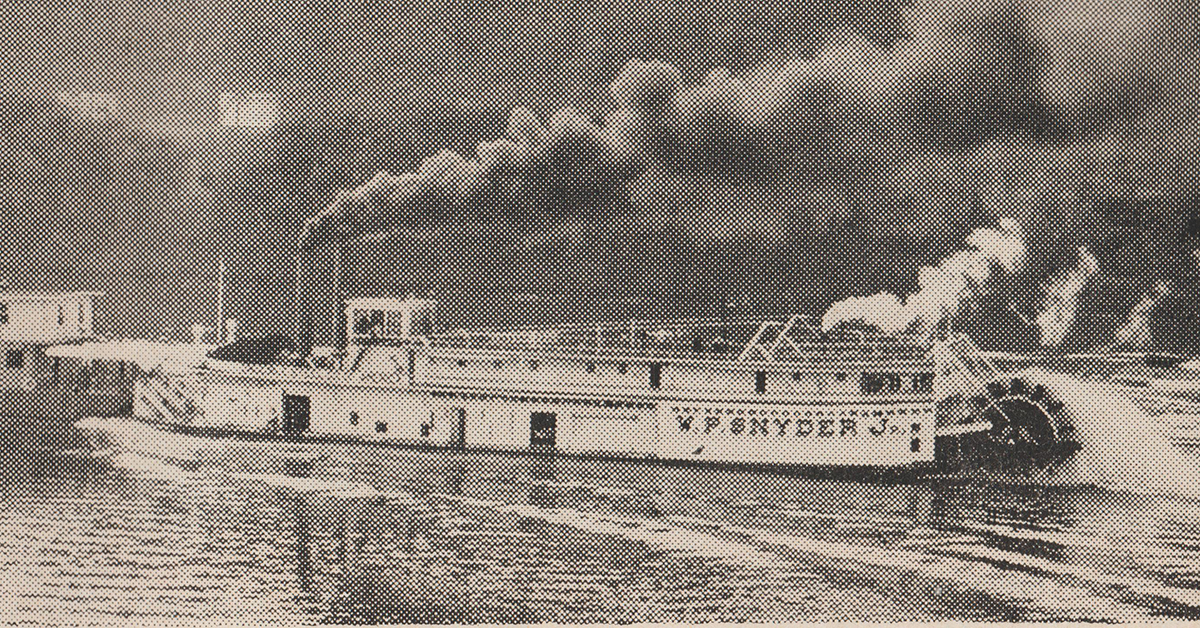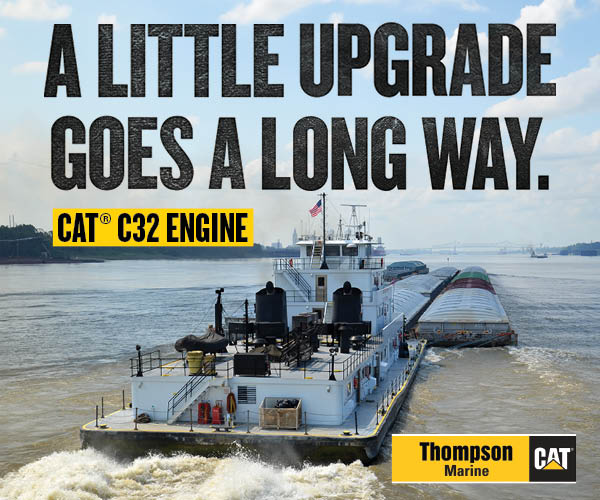The last column detailed the early years of the steam sternwheel towboat W.P. Snyder Jr., built in 1918 on the bank of the Allegheny River in Pittsburgh by James Rees & Sons for Carnegie Steel. It was originally named W.H. Clingerman and had a steel hull measuring 152 feet by 29.1 feet with a depth of 4.8 feet. The Rees condensing engines were 14’s, 28’s with a 7-foot stroke and rated at 750 hp. There were four coal-fired boilers.
In 1937, the boat was extensively rebuilt with a new hull that was both wider and deeper. Following this, the hull dimensions were 151.7 feet by 32.3 feet with a depth of 5.7 feet. In 1938, Carnegie-Illinois Steel, as the company was then known, changed the name of the boat to J.L. Perry. In the spring of 1945, the name was changed to A-1, and the Homestead, a sister vessel that Rees built in 1919, was renamed A-2. However, not long after the renaming, both vessels were sold to Crucible Fuel Company, a subsidiary of the Crucible Steel Company of America.
The A-1 was renamed W.P. Snyder Jr. in honor of the chairman of the board of Crucible, and the A-2 was named W.H. Colvin Jr. after the company’s president. These two towboats, more than 25 years old at the time, still used the bell-pull system, which involved the pilot ringing different bells to signal to the engineer what engine speed and direction was needed, rather than having an engine room telegraph or indicator.
Compared to newer diesel boats, they were antiques, yet they were much more modern than the two wooden-hulled towboats in the Crucible fleet at the time. Those wooden-hulled vessels were the Rezistal (dating to 1882) and the Crucible (dating to 1904). The Crucible was retired in November 1945, and the Rezistal was retired in 1948 and burned while laid up in 1949.
The W.P. Snyder Jr. and W.H. Colvin Jr. delivered coal from mines on the Monongahela River to the Crucible mill at Midland, Pa., near Ohio River Mile 36 for most of the next 10 years. In 1951, Crucible Steel entered the diesel era with a new 1,066 hp. boat, the Crucible, built at Dravo Corporation’s shipyard at Neville Island, Pa.. By 1953, the Colvin was dismantled, and the Snyder was relegated to spare boat status and tied up at Midland. During this time, many sternwheel steam towboats were dismantled and scrapped in favor of the more efficient diesel craft.
The August 20, 1955, issue of The Waterways Journal included a one-column story on page 7 that said the “handsome steam towboat W.P. Snyder Jr.” would be formally presented on September 17 to the Ohio Historical Society during the annual meeting of the Sons & Daughters of Pioneer Rivermen (S&D) at Marietta, Ohio. The Snyder was to become a permanent floating exhibit moored on the bank of the Muskingum River at Marietta near the Campus Martius Museum. The story stated that The Waterways Journal (meaning owner/publisher Capt. Donald T. Wright) had kept this story “under wraps” for some time while “awaiting the consummation” of the deal.
The ”deal” began with a letter from Capt. Frederick Way Jr., a prominent river historian and president of S&D, to Mr. William Penn Snyder Jr., Crucible board chairman. Capt. Way, knowing that the steamer Snyder was laid up and an endangered species, asked if Crucible would consider donating the vessel to promote the history of sternwheel steam towboats.
Snyder and the Crucible board not only were agreeable to the proposal but also went to great lengths to bring the boat up to proper operating condition, up to and including a fresh coat of paint, so it could arrive at Marietta under its own steam. To handle the large number of guests making the trip, a quarterboat was secured from U.S. Steel for the boat to push. The crew of the boat included Capt. Way as master and Capt. Tom Kenny as pilot. Eugene Kennedy was chief engineer, Harry Lampert was striker, Lovell Greenlee was mate, Gertrude Watson was cook, and Pauline Byers and Marie Guesman were maids. Charles McShane and Wayne Watson were deckhands, while William Reed, Russell Lintner and Paul Seabrook were honorary deckhands.
Many river veterans and aficionados were aboard when the boat blew a departure whistle to get underway on September 12, 1955. Over the next five days, the W.P. Snyder Jr. steamed downstream, blowing many whistles, accompanied by the strains of an air calliope placed aboard for the trip. The boat stopped each evening so that the guests on board could lodge at nearby hotels. Upon arrival at Marietta about 2:30 p.m. on September 16, William P. Snyder Jr presented the boat to Paul B. Belden Sr., president of the Ohio Historical Society.
Following the ceremonies, the Snyder was unfaced from the quarterboat and backed down the short distance from the Marietta riverfront to the mouth of the Muskingum River. With stacks hinged back to clear low bridges, it entered the Muskingum and then Lock 1, which had been abandoned the year before. Volunteers from the Marietta Boat Club hand-operated the lock to allow the Snyder to transit, making it the last steamboat to lock through there. The lock was later removed in conjunction with the raising of the Belleville Lock & Dam pool.
Upon arrival at the foot of Sacra Via Street, the boat landed with the final engineroom bells being answered by 78-year-old George Ehringer, serving as honorary engineer. Ehringer had been the first engineer on board the boat in 1918 when it was named the W.H. Clingerman. Ehringer was the grandfather of Capt. Dick Ehringer, well known by many present-day rivermen.

The W.P. Snyder Jr. has been a popular exhibit at Marietta for the past 70 years, with the exception of forays out of the Muskingum for necessary shipyard repairs. The vessel underwent an extensive hull renewal in 2009. Prior to that, this writer spent a delightful day with the late Capt. Bill Judd, marine surveyor and chairman of the board of governors for S&D, crawling the hull of the Snyder. Our task at the time was to ascertain if the hull widening of 1937 had been done with riveted or welded construction. Grants for the work would have required going back to rivets, if that was the case. Thankfully, we found that the 1937 hull was welded.




